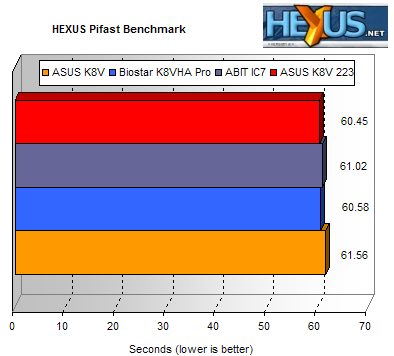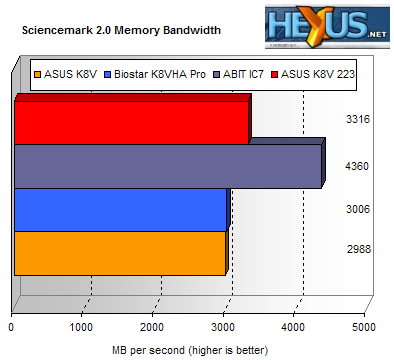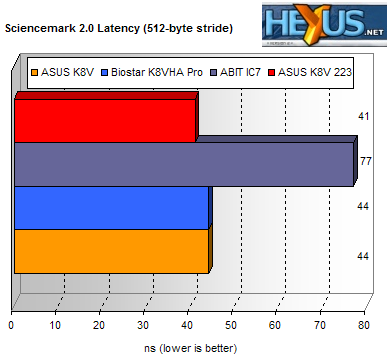Memory Tests
A few tests to stress the memory subsystem. The objective is to make sure the memory performance of the K8V (and the other boards on test) is as it should be, with no unusual problems or anomalies.Pifast first, the HEXUS custom test to 10 million places. It's sensitive to changes in memory controller performance and given that the memory controller is on the CPU with Athlon 64, chipsets that allows good control over set latencies should perform identically when used with the same settings. We're also looking for the performance delta between K8V and the Pentium 4 system, to see where overall performance lies.

The ASUS is nearly a second off the Biostar time initially, but claws it all back when running 9 x 223. Pifast, for the most part, is prophetic. A running order here, between similar systems running the same CPU at least, is usually a good indication of the running order throughout all our benchmarks. Look for the K8V to be just a shade slower even if it's not noticable in real world usage, than the Biostar, in the rest of our tests.
Sciencemark 2.0's memory bandwidth test is a useful alternative to the same unbuffered memory test in Sandra, since it tests SIMD memory bandwidth performance and also cache latencies, saving us some time. Here's the memory bandwidth test results first.

Essentially identical memory bandwidth between the two Model 3200+ systems running at 10 x 200, showing that DDR400 mode is working correctly. A rough 93% efficiency is something memory controllers dream of. ~3.3GB/sec is spot on for DDR446 in the 9 x 223 case, confirming it is actually running at those speeds. A single channel means the Athlon 64 systems lose out to the dual channel DDR Pentium 4 system in raw number terms, but performance on Athlon 64 isn't dependent as much on bandwidth, due to a larger L2 cache and low latency memory accesses.
Main memory latency results now. The lower the better.

A single bar graph tells us what a complex Cachemem plot would tell us, without the complication. Memory accesses by the DDR controller are mighty quick on Athlon 64. Deeper analysis is something for another article.
So far, the K8V has shown us that its memory subsystem is purring away nicely, giving us a decent basis for the rest of the tests. Of course Pifast is also sensitive to CPU speed, so it's a measure of that too, but we use it for memory analysis initially. Onto some CPU bound tests.









